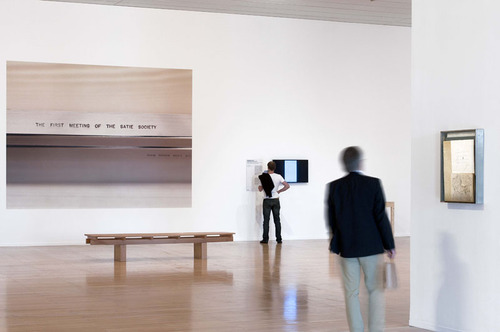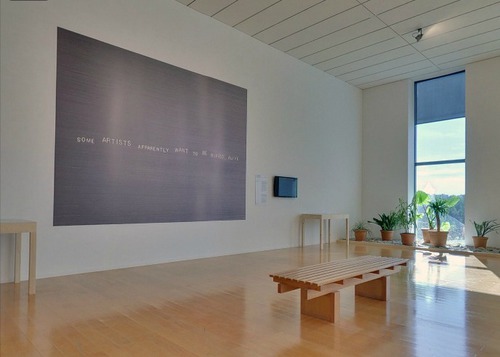
It’s been a while since I had a good old-fashioned photomuralling around here, and this one comes from an unexpected source: John Cage. Mostly.
I’d seen installation photos before of MAC Lyon’s Cage’s Satie: Composition for Museum , an exhibition curated by Laura Kuhn from the John Cage Trust. The show includes several composition-related installations, and a gallery dedicated to The First Meeting of the Satie Society, (1985-1992),
Cage’s stunning late-life collaborative merger of poetry, performance, visual art, sculpture, and music. This work was conceived as a collection of “presents” for Erik Satie, an invitation by John Cage to his esteemed artist friends to fill a Marcel Duchamp-inspired cracked glass valise with words and images bound into eight hand made books. Contributors in the visual aspects include Jasper Johns, Robert Rauschenberg, Sol LeWitt, Robert Ryman, and Cage himself.
[I wrote about this Satie-inspired project last year.]
But it wasn’t until Alex Ross posted the top image that I realized what these giant wall pieces were: they’re large-scale photos of close-ups of various texts imprinted on the steel Satie Society valise. That’s the title, obviously. Here’s another, “Some artists apparently want to be buried alive.” which, hmm. I can’t find any mention of the quote online, but given that it’s incised on an indeterminate handful of mostly unpublished metal boxes scattered to the collecting winds, I guess that’s not a surprise.

What is a bit surprising, though, is the visual boldness of the photos, which really dominate an otherwise spare, small-scale show in a vast space. As nice as they look, I guess they’re an exhibition design, not things. Except, of course, that they are.
There’s this atypical situation that I keep coming back to, the objects and artifacts of Cage. Things that, if he’d had a more materialist view of art, we might be able to consider from the perspective of art, if not to actually call them art objects.
This awkwardness is reinforced in a way by the surprisingly traditionalist view of artmaking that Cage held onto, at least for himself. However experimental or avant-garde his process–feather paintings, smoke drawings, a few prints, even this slightly affected Duchamp-related valise–the results were modest and old-school.
I guess I’m wondering, fantasizing, plotting, for a more interesting way to be a Cage collector when the available works, such as they are, are not that compelling. So I have questions about them, yes, but I also find these giant photo mural prints kind of sexy.
